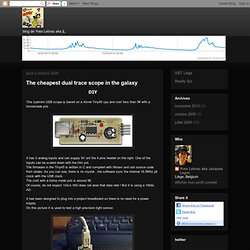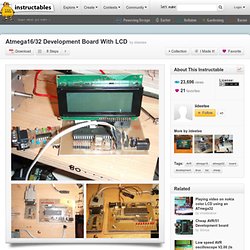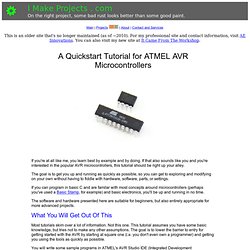

AVR Embedded Microcontroller Resources. Updated June 17, 2008 My page was officially 10 years old on February 18, 2008.

I have had hundreds of thousands of visits. Thanks to everyone who has visited and especially to those who have made suggestions and provided useful and interesting links. Printf and scanf examples for Microcontrollers - Hacked Gadgets. The cheapest dual trace scope in the galaxy. This submini USB scope is based on a Atmel Tiny45 cpu and cost less than 5€ with a homemade pcb It has 2 analog inputs and can supply 5V ont the 4 pins header on the right.

One of the inputs can be scaled down with the trim pot. The firmware in the Tiny45 is written in C and compiled with Winavr and usb source code from obdev. As you can see, there is no crystal , the software sync the internal 16.5Mhz pll clock with the USB clock. Atmega16/32 Development Board With LCD. This instructable shows, how to do your own development board for Atmega16 or Atmega32 processors.The Internet is full of home made development boards, but I think that, there is room left for another one.

This board have been very useful on my projects and I actually designed and made it to serve one of my project. What it offers? - ISP-connector.- Adjustable reference voltage for AREF with trimmer.- 8 leds connected PORTA with removable jumpers, so you can use leds also with another ports.- Spike bars for PORTA, PORTB, PORTC and PORTD.- Modified spike bar for LCD-screen (4 bit)- rs232 serial port connector- Removable rs232 module- Regulated 5V What you will need? (parts for main board) An AVR-based logging wattmeter. This device monitors household power usage and logs it to an SD card.

A simple analog front-end amplifies the signals from voltage and current detectors and an ATmega168 microcontroller computes the power consumption using the formula P=V*I. The voltage and current are each sampled at 9615 Hz so the integration should be fairly accurate even for highly non-sinusoidal loads such as computers or fluorescent bulbs. A graphical LCD shows the power usage as a strip chart and can also act as an oscilloscope to display the voltage and current waveforms. MAKE: Blog: ATtiny breadboard headers. Alex, of Tinkerlog, writes: The Problem: Whenever I was prototyping on a breadboard I was annoyed by all the wires to setup before the actual project could begin.

Arduino projects were much easier. The 6 pin ISP (In System Programming) header alone was troublesome. Ghetto Programming: Getting started with AVR microprocessors on. Microprocessors are so cheap these days.

If only there were a way to program them up just as cheaply... *wavy dream-sequence lines* In this instructable, find out how to build up a complete AVR microprocessor toolchain: compiler, programmer software, programmer hardware, and some simple demos to get your feet wet. 06111, HTTP/TCP with an atmega88 microcontroller (AVR web server. Introduction A UDP command interface is sufficient for most applications but an integrated web-server is much more universal and easier to use.

How to build a web server into an atmega88 chip? Ethernet Controlled Security System - Hacked Gadgets - DIY Tech. Ahmad Masri has used an inexpensive ethernet chip called the WIZ5100 to create a simple but flexible ethernet based security system.

The low cost of the ethernet chip makes connecting projects to computers or other microcontroller based devices very appealing. MAKE: Blog: Arduino and a tri-axis accelerometer. AVR DDS signal generator V2.0 - Scientific, embedded, biomedical. Finally second and improved AVR DDS signal generator is here.

First AVR DDS V1.0 generator was only an attempt of running DDS algorithm without any amplitude control. This time I still wanted to keep things simple like minimum count of widely accessible components circuit, single sided PCB that comes together with good functionality. I Make Projects - A Tutorial for Starting with AVR Microcontroll. A Quickstart Tutorial for ATMEL AVR Microcontrollers If you're at all like me, you learn best by example and by doing.

If that also sounds like you and you're interested in the popular AVR microcontrollers, this tutorial should be right up your alley. Short Range Personal Radar. The idea to create a type of close proximity radar system came from a student in one of my classes. We went ahead and decided to streamline the idea into the course as one of the projects we'd build. After a week or two of prep time we finally agreed on the project setup & parts that we'd use. This is not meant to be an advanced project, thusly the difficulty is set at medium. Below is an example of what short range personal radar could be used for. Build a dsPIC Oscilloscope and Spectrum Analyzer: Scopey II - Th. Control real world devices with your PC - The World's Bigge. Parts list: Picaxe 08M chip available from many sources including Rev Ed (UK), PH Anderson (USA) and Microzed (Australia) Protoboard, servo, microswitch, 9V battery, 4xAA batteries and holder, tag strip, 10k resistor, 22k resistor, 33uF 16V capacitor, 0.1uF capacitor, 7805L low power 5V regulator, 10k pot, wires (solid core telephone/data wire eg Cat5/6), 6V lightbulb, D9 female socket and cover, 2 metres of 3 (or 4) core data wire, battery clips The above companies also sell USB to serial devices which are useful for laptops which don't have a serial port.
It is worth noting that some USB to serial devices don't work as well as others and it is worth getting one from one of the above suppliers as they have been tested for use with picaxe chips. What every programmer should know about memory, Part 1. September 21, 2007 This article was contributed by Ulrich Drepper [Editor's introduction: Ulrich Drepper recently approached us asking if we would be interested in publishing a lengthy document he had written on how memory and software interact. We did not have to look at the text for long to realize that it would be of interest to many LWN readers. Memory usage is often the determining factor in how software performs, but good information on how to avoid memory bottlenecks is hard to find.
This series of articles should change that situation. The original document prints out at over 100 pages. Reformatting the text from the original LaTeX has been a bit of a challenge, but the results, hopefully, will be good. Many thanks to Ulrich for allowing LWN to publish this material; we hope that it will lead to more memory-efficient software across our systems in the near future.] 1 Introduction In the early days computers were much simpler.
RAM hardware design (speed and parallelism). Blog: HOW TO - Getting Started with Arduino. I’ve compiled a brief tutorial on getting started with Arduino for the absolute beginner. I’ll cover where to learn, what to buy, and where to go for help. Why should you crafters be interested in Arduino? The Arduino platform, more-so than any other way of incorporating electronics into your projects, is geared towards do-it-yourselfers. It’s open source (both on a hardware and software level), so the community plays a large role in its development and improvement. Crafting is a community endeavor; individuals share tips, tricks, techniques, skills, and materials all the time. Where to learn First and foremost is the Arduino website. What to buy – the absolute basics for learning the platform The board: I recommend the USB Arduino board, pre-assembled, for first-timers.
Photo: Sparkfun Some LEDs (light-emmiting diodes): most of the basic tutorials involve lights. uC Hobby » Blog Archive » Identifying Electronic Components. How-to identify and locate information for electronics components you can recycle from discarded gadgets. Brandon gives us example pictures and descriptions for most types of electronics components to help you stock up your home electronics lab. This is a must read for new electronics hobbyist. This article was submitted by Brandon Uhlig as part of the “Hobby parts for articles ” program. Brandon receives a Modern Device Company Bare Bones Arduino Kit for this fantastic article. Let Brandon know that you appreciate articles such as this by posting a comment.
Evil Mad Scientist Laboratories - Resources for getting started. Pico. AVR projects. Karosium. Microchip PIC.